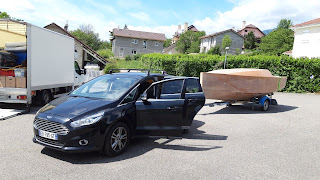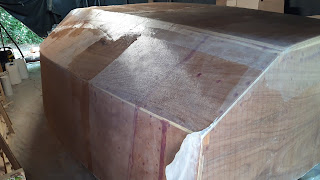After the hull fiasco I turned the hull over and started on closing up the top side. The cockpit plating went on covered in 3 layers of epoxy in places that will be hard to reach (the for now closed-off lazarette). Other than that nothing special to report here, standard procedure was followed: pre-wet, glue and screw with temporary fasteners, fill the screw holes with epoxy and screw in final stainless fasteners.
Same thing for the foredeck:
The main deck, or the cabin top is made of two plates joined on a butt block running amidships.
In the end a hatch will be mounted, probably in the opposite direction to what is in the picture below - to reduce the probability of a wave delivering all of it's content inside the cabin.
All that rested was glassing the newly build deck. Alas, I had no time for that so I decided to waterproof the entire top side with epoxy and some varnish. I just gooped it on knowing that I will have to sand it off anyway before actually putting on a reinforcing layer of glass at some point after the move.
I did turn out looking kinda good, but not good enough for me to want to keep the wood visible. It is going to be painted white eventually.
tot de volgende keer




















































